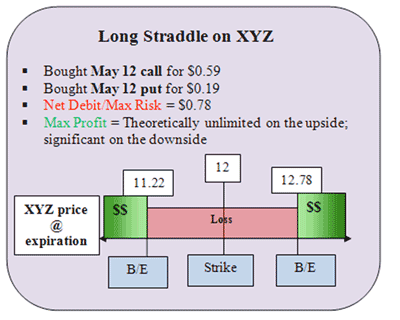Learn to construct a long straddle position using options as a means of capitalizing on momentum; even if the underlying equity fools the market and heads in an unexpected direction.
Stock traders with a basic knowledge of options understand that you typically buy calls when you expect the underlying stock to power higher, and buy puts on expectations for a downside move.
However, those of you still hesitant to jump on the growing options bandwagon should know that you don't have to be firm in your directional forecast to make money.
Good earnings news means a rising stock, right? Not always, of course. What if the news turns out to simply be an April Fools joke on you, the trader? We’ve all been in trades that “absolutely should be going up on this news,” but that wind up doing exactly the opposite.
However, there are ways to keep yourself from being on the receiving end of the market’s April Fools antics. In fact, by constructing a long straddle, you can capitalize on a stock's momentum regardless of which way the pendulum swings.
First, let's review the basics. To construct a long straddle, simply buy an equal amount of puts and calls with the same strike and expiration date. The options will typically be at or near the money, while the expiration month should coordinate with the time frame of the expected price swing.
However, remember that due to the effect of time decay on an option's price, longer-term contracts will cost you more—which will impact both your breakeven rails and maximum risk. But more on that in a minute.
So, why employ the long straddle strategy? As alluded to earlier, the goal is to capitalize on a monumental move in either direction before the options expire, making this the ideal play ahead of a company's turn in the earnings spotlight, the release of drug-trial data, a key courtroom decision, or any other notable date on the corporate calendar.
As the shares power higher or gravitate lower, one option will depreciate while its counterpart gains value, with the objective being for the profit from one to outweigh the loss of the other.
In the wake of a dramatic move to the downside, you can make a generous profit, though your maximum reward is capped at the strike price less the initial net debit (since the furthest a stock can fall is to zero).
However, following a significant rally, your maximum reward is theoretically unlimited, as there's technically no limit to how high a stock can advance.
Meanwhile, one of the primary selling points of the long straddle is the limited risk, which is capped at the premium paid at initiation (not including brokerage fees).
But, in order to avoid forfeiting the net debit, you need the underlying stock to violate one of two breakeven rails by expiration: The strike minus the initial net debit, or the strike plus the initial net debit. In other words, the more you pay for the options at initiation, the bigger the move needed to generate a profit…and the more you stand to lose on the play.
That said, let's examine a theoretical straddle on drug maker XYZ, which we'll say is flirting with the $12.50 level ahead of a crucial ruling from the Food & Drug Administration (FDA).
As such, we're going to construct our straddle by purchasing both the May 12 put and call, which were last asked at $0.19 and $0.59, respectively. As a result, our trade was established for a net debit of $0.78 per pair of options, which—remember—represents the most we can possibly lose.
The combined premium paid also determines our breakeven window. More specifically, in order to reap a reward, we need the shares of XYZ to do one of two things within the options' lifetime: Either retreat south of the $11.22 level (strike minus net debit) or rally beyond the $12.78 level (strike plus net debit).
By Andrea Kramer, contributor, Schaeffer’s Trading Floor Blog






















